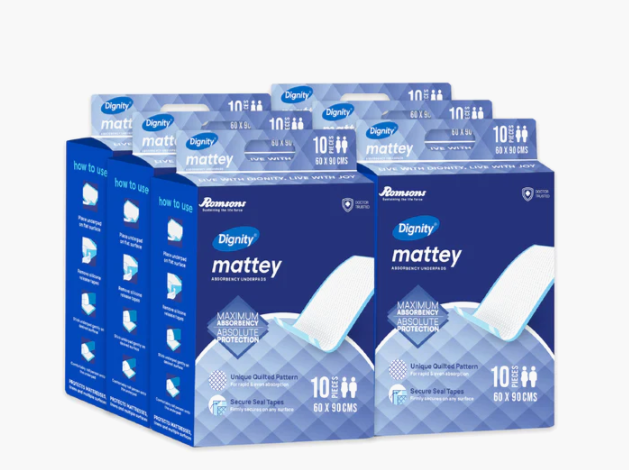An underpad is an essential healthcare product designed to protect surfaces from moisture and fluid leakage. Whether used in hospitals, nursing homes, or residential settings across India, an underpad sheet provides reliable protection while ensuring comfort and dignity for individuals managing bladder control issues or recovering from medical procedures.
This comprehensive guide explores everything you need to know about these versatile protective products.
What is an Underpad?
An underpad is a rectangular absorbent pad with a waterproof backing designed to protect bedding, furniture, and other surfaces from fluids. Also known as bed pads, incontinence pads, or chux, underpads feature multiple layers that work together to absorb moisture quickly, lock it away from the skin, and prevent leakage.
The modern underpad typically consists of:
- A soft and non-woven top layer that wicks moisture away from the skin
- A highly absorbent core that traps and holds liquid
- A waterproof backing that prevents leakage onto surfaces
- Sometimes, additional features like odour control elements or adhesive strips
Types of Underpads Available in the Indian Market
Underpads come in various forms to meet different needs throughout India:
1. Disposable Underpads
- Single-use design for optimal hygiene
- Various absorbency levels available in the Indian market
- Convenient for travel and short-term use
- Often more budget-friendly for occasional needs
2. Reusable Underpads
- Washable and designed for multiple uses
- Eco-friendly option for environmentally conscious households
- More economical for long-term needs in family care settings
- Often feature soft fabric tops for greater comfort in India’s climate
- Higher initial investment, but more affordable over time
3. Specialty Underpads
- Larger-sized underpads: Extra coverage for comprehensive protection
- Quilted underpads: Additional padding for comfort and pressure distribution
- Antimicrobial underpads: Special features to promote better hygiene
- Gentle-material underpads: Designed for sensitive skin concerns
- Odour-neutralising underpads: Technology to maintain freshness and dignity
Key Benefits of Using Underpads
The underpad offers numerous advantages in healthcare and home settings:
- Surface protection: Keeps beds, chairs, and other furniture dry and clean
- Skin health: Quality underpad sheets help maintain skin integrity by reducing moisture exposure
- Infection control: Creates a barrier between bodily fluids and surfaces
- Time-saving: Reduces laundry and cleaning time
- Versatility: Can be used on beds, chairs, examination tables, and during procedures
- Dignity preservation: Provides discreet protection
How to Choose the Right Underpad for Your Needs
Selecting the appropriate underpad depends on several factors that are important to consider for Indian households:
1. Absorbency Level
- Light: For minimal moisture or as a preventative measure during recovery
- Moderate: For regular management of bladder control issues or post-surgical care
- Heavy: For comprehensive protection or high-volume fluid management
- Maximum: For overnight use or when extended protection is needed
2. Size Considerations
Standard underpad sizes available across India typically include:
- Small (45 x 60 cm): For chairs or limited areas
- Medium (60 x 90 cm): Standard bed protection for most individuals
- Large (90 x 90 cm): Full bed coverage for greater protection
- Extra Large (120 x 90 cm): Comprehensive coverage for special needs
3. Material Quality
- Top Layer: Look for soft, non-irritating materials
- Core Performance: Consider how quickly it absorbs and locks away moisture
- Backing Reliability: Ensure it prevents leakage
4. Additional Features
- Adhesive backing: Keeps the underpad in place
- Odour control: Neutralises smells
- Tuck-in flaps: Secures the pad to the mattress
- Quilted surface: Provides extra comfort and leak protection
Proper Usage and Placement
To maximise the effectiveness of an underpad:
- Correct positioning: Place the underpad sheet with the coloured waterproof side down and the white absorbent side up
- Strategic placement: Position under areas most likely to experience wetness
- Smooth surface: Ensure the pad is flat and wrinkle-free to prevent pressure points
- Regular checking: Monitor regularly and change when wet to maintain skin health
- Overlap method: For full bed protection, use multiple pads with a slight overlap
Care and Maintenance
Proper care extends the life of underpads:
1. For Disposable Underpads:
- Store in a cool, dry place
- Check expiration dates if applicable
- Dispose of used pads in appropriate waste containers
- Never flush down toilets or drains
2. For Reusable Underpads:
- Follow the manufacturer’s washing instructions
- Typically machine washable at 60-90°C
- Avoid fabric softeners that may reduce absorbency
- Dry on low heat setting or air dry
- Replace when absorbency diminishes
Other Uses for Underpads
The versatility of underpads extends to many applications:
- Post-surgical recovery: Protecting bedding during drainage or wound healing
- Childcare: During toilet training or for diaper change protection
- Pet care: For ill pets with issues
- Craft projects: Protecting surfaces during messy activities
- First aid: Creating a clean surface in emergency situations
- Outdoor activities: As a moisture barrier for sitting on damp ground
- Food service: Under serving trays to catch spills
Final Thoughts
The underpad plays a crucial role in healthcare, caregiving, and maintaining quality of life for many individuals. From providing surface protection to supporting skin health and dignity, these versatile products offer practical solutions for a variety of needs.
Whether choosing disposable or reusable, understanding the features and benefits of an underpad sheet helps ensure you select the right product for your specific requirements. With continued innovations in materials and design, today’s underpads offer better performance, comfort, and discretion than ever before—helping users stay dry, comfortable, and confident.



